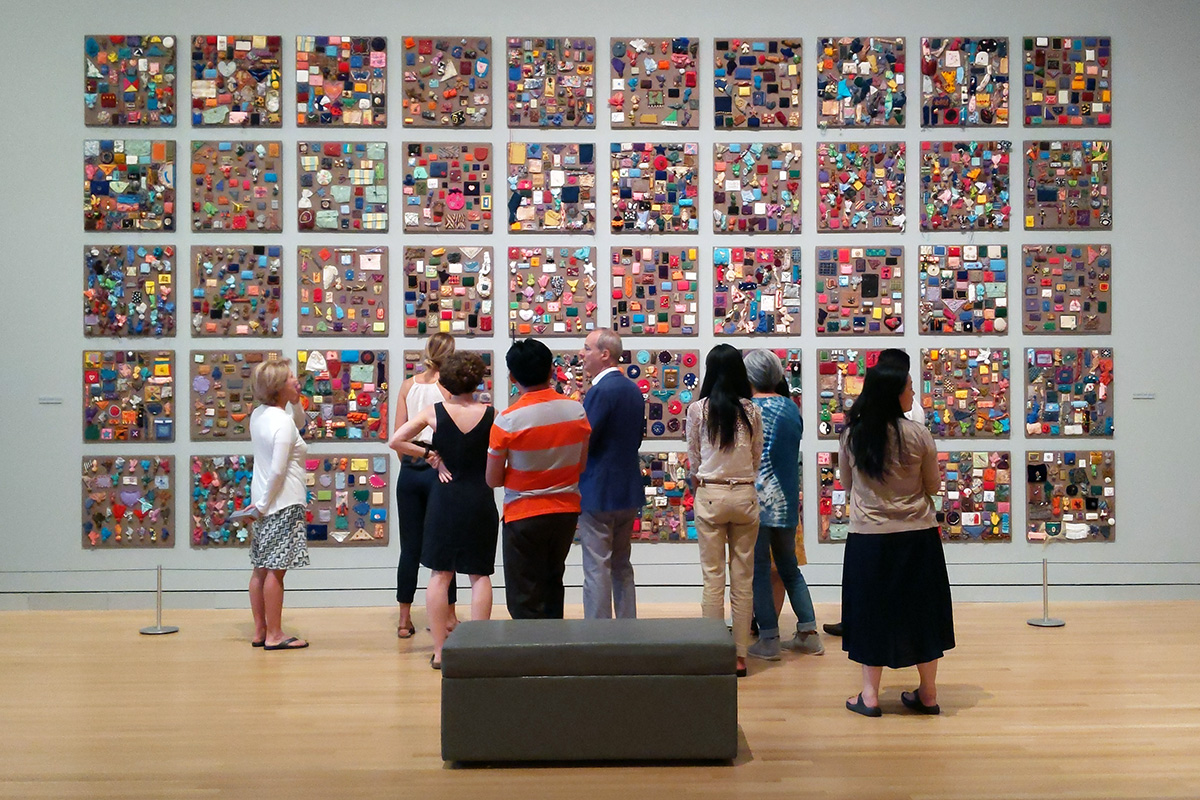In the airy lower level of the George Washington University Textile Museum in Washington, D.C., brightly colored balls of yarn hang from the ceiling of the “Textiles 101” education space. A giant practice loom with thick, half-woven purple and yellow yarns stands to one side of the room, and samples of raw and processed bark, silk, alpaca wool, and other yarn-making materials sit at the other.
This was the last stop on the first day of a five-day, multi-city study tour for members from Bhutan’s Royal Textile Academy (RTA), the preeminent textile institution in Bhutan. From June 30 to July 4, the delegation was able to meet curators and educators behind the scenes of Smithsonian and other prominent museums in the area, to bring back lessons, ideas, and insights on how to continue to grow their own museum and its audience.
Like many places around the world, Bhutan experience challenges in sustaining their cultural traditions and the interest of the youth as urbanization and globalizations bring changes to the communities. To mitigate these threats to traditions, the Center for Folklife and Cultural Heritage partnered with RTA in 2018 for a three-year project, Sustaining Bhutanese Weaving Traditions. The study tour fulfilled part of our promise to offer insight into the full depth and breadth of the Smithsonian and other cultural institutions’ work and knowledge.
In the Textile Museum’s “Textiles 101” space, which helps visitors understand the foundational materials, techniques, and tools for textile weaving, the group engaged by touching the educational materials, taking notes, and peppering curator Lee Talbot with questions. The consensus was clear: a teaching resource like this is needed in Bhutan.

“We run a successful student program at the RTA, but the visit to Textiles 101 at the Textile Museum exposed us to how we can better engage the children through interactive materials,” deputy director Kuenga Lhendup reflected. “While information can be relayed in multitude of ways, hands-on interactive and visual learning is perhaps the best for children.”
The following day, the team met with Carol Wilson, the Lunder Education Chair at the Smithsonian American Art Museum, for a tour of the Luce Foundation Center. Here they offer concerts, scavenger hunts, yoga, and other activities targeting the needs of the public. The goal is to attract as diverse a community as possible into the museum, remind them that the space is for them, and hopefully turn them into regular visitors. The RTA team, who will break ground on a conference center and additional programming space adjacent to their museum later this year, were especially interested in the many perspectives on how to bring in new and diverse audiences, fully utilizing their space.
In the following days, the team explored youth-oriented programs across the Smithsonian. At the National Museum of Natural History, they explored Q?rius, a buzzing interactive and experimental learning space, talked with teenagers from the YES! program as they scanned objects with an electron microscope, and handled human bones along with a school program introducing youth to forensic tools and techniques. One delegation member was ready to change fields to the wonders of science! Though the focus of these programs is far from that of Bhutanese textiles, the group walked away considering how these methods might translate into ways for Bhutanese youth to engage with their textile heritage.

At the National Museum of American History, members of the delegation stopped by Spark!Lab and Wonderplace—vibrant, kid-filled pockets of the sprawling museum—to see how they engage their youngest visitors and make their collections accessible to them.
The D.C. leg of the trip ended at the Hirshhorn’s ARTLAB+, a technological wonderland created for area teens to develop their creative voices. Two ARTLAB+ participants led the tour, showcasing the sound studio, 3D printer, and tricked-out computers. OnRae Watkins, the senior manager of teen programs, shared their core philosophy on engaging kids: HOMAGO, or “Hang Out, Mess Around, and Geek Out.” For her, and the rest of the ARTLAB+ team, the program is designed to give youth the space to engage on their own terms and help draw them into spaces like the Hirshhorn for a lifetime.
“What we know and, hence, how we do things is a result of the knowledge and information we have accumulated,” Lhendup concluded. “We function within the realms of our intellect. I can claim with certainty that this study tour has opened the horizons of our knowledge and experience and widened our intellectual lenses. We go back with renewed zeal and energy to contribute to the cause of the RTA.”
Introducing children to textiles can help to build interest and appreciation for the traditions. Over a lifetime, this can translate into a sustained commitment to purchase and wear handmade Bhutanese textiles. Over the next year, the Center will work with the RTA to design and implement education and public programs that will engage local Bhutanese while also bringing both weavers and the practice of weaving to fully activate the museum space.
Jake Naughton is a photographer and communications specialist working with the Center for Folklife and Cultural Heritage.


